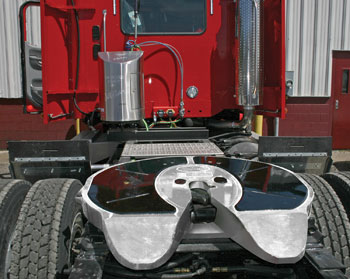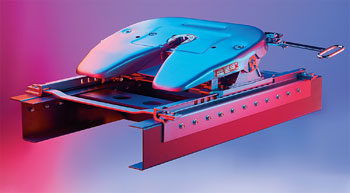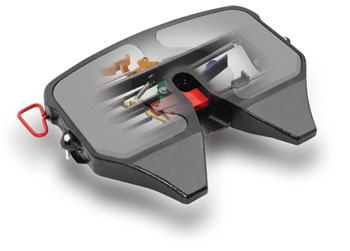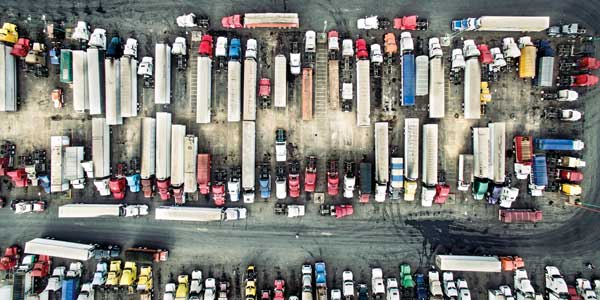Fifth wheel technology continues to progress, with benefits from reduced weight and maintenance. In addition, the growing acceptance of air-actuated locking and in-cab monitoring of fifth wheel lock status enhances operator safety and saves time. Landing gear has been upgraded, to include lower-weight components, increased safety features and corrosion resistance.
Lighter weight
Interest in improving fuel efficiency and increasing payload has made reducing excess weight a priority for heavy-duty truck component makers. When it comes to fifth wheels, manufacturers are opting for aluminum or even composite materials to reduce the weight of the top plate, or they have redesigned current products to save pounds.
 In the less-weight category, SAF-Holland Inc. offers the FWAL lightweight aluminum fifth wheel. Designed by SAF-Holland and forged by Alcoa, this fifth wheel is made from the same alloy as Alcoa’s aluminum truck wheels, says Rob Nissen, the company’s manager – technical services/training. The FWAL is rated for 55,000 lbs. maximum vertical load and 150,000 lbs. maximum drawbar pull (the same as its FW31 and FW35 fifth wheels), and is backed by SAF-Holland’s 6-year/600,000 mile performance guarantee in over-the-road applications. “It’s a premium product that is popular with tankers and bulk haulers because of the increased payload capability,” he explains. “These fleets ‘have done the math’ and found payback in approximately 16 months versus a cast steel fifth wheel,” he notes.
In the less-weight category, SAF-Holland Inc. offers the FWAL lightweight aluminum fifth wheel. Designed by SAF-Holland and forged by Alcoa, this fifth wheel is made from the same alloy as Alcoa’s aluminum truck wheels, says Rob Nissen, the company’s manager – technical services/training. The FWAL is rated for 55,000 lbs. maximum vertical load and 150,000 lbs. maximum drawbar pull (the same as its FW31 and FW35 fifth wheels), and is backed by SAF-Holland’s 6-year/600,000 mile performance guarantee in over-the-road applications. “It’s a premium product that is popular with tankers and bulk haulers because of the increased payload capability,” he explains. “These fleets ‘have done the math’ and found payback in approximately 16 months versus a cast steel fifth wheel,” he notes.
SAF-Holland’s integrated low-weight slider system, the ILS, has been designed for easy bracket height conversion with special one-piece, cast mounting brackets. When mated with the company’s FW17 top plate, the assembly can save up to 85 lbs. compared to competitive fifth wheels. The ILS is available in 7-, 8-, and 9-in. mounting heights, and travel lengths of 12, 24, 36, and 48 in. Options include an air release slide bracket that features a stainless steel air cylinder and easily reached outside plunger adjustment.
JOST International Corp. has taken a different path by taking the weight out of the mounting structure in slider applications. Rich Carroll, vice president of sales and marketing, says that move has resulted in the potential savings of 100 lbs.––without the added price of lightweight materials and without sacrificing the integrity of the locking mechanism. This product, called the Pro Tech slider, is a new release of the company’s advanced inboard sliding assembly.
In January 2010, the company will also release the JSK57USL cast ductile iron top plate that features a weight savings of 20 lbs. while bringing a vertical load rating of 57,000 lbs. This weight savings has been accomplished primarily through numerical modeling in the design process. The new top plate will incorporate the same locking mechanism and principle of operation as the JSK37USL top plates now in operation, while including improvements such as a drop handle as an integral part of the casting, says Carroll.
Later this year, Fontaine Fifth Wheel will be introducing a new lightweight product, according to Terry Mennen, vice president of sales and marketing at the company. This lightweight steel fifth wheel slide assembly will save fleets over 100 lbs. compared to several other fifth wheel assemblies. The wheel is designed for on-highway use only, including tanker operations, and is available for both inboard and outboard mounts. It utilizes the company’s anti-high hitch locking system, and will be available with air actuation.
Low or no lube options
Manufacturers are increasingly finding ways to reduce the amount of grease (plus time and labor required) needed to lubricate the fifth wheel top plate and locking mechanism. As a result, various “low lube” or even “no lube” options are offered. Benefits include reduced fifth wheel lubrication cost and time, and extended maintenance intervals that can improve shop productivity. The absence of grease allows technicians to work faster, safer and cleaner. Less grease also means shops can eliminate steam cleaning and costly grease disposal. There’s less chance of grease contamination of storm and ground water, which helps meet EPA regulations and preserves the environment. On the road, low-lube/no-lube options help to avoid citations and fines for excess grease on drive axle and frame, and driver productivity improves because there is no regreasing on the road.
SAF-Holland’s Nissen also says its NoLube option saves on steer tire wear/scrub, because it helps maintain consistent steer effort––even in sharp turns––and provides a smoother, more fluid ride and constant feel for the way the trailer pulls. SAF-Holland’s replaceable NoLube plate inserts made of urethane high-molecular weight (UHMW) material are mechanically bonded to a perforated steel plate that provides low friction performance and extends the life of the lube plate compound, eliminating the need for lubrication. The grease-compatible material is strong and durable; if struck, it will gouge but not be destroyed. A special alloy on the kingpin contact surfaces of the lock jaws provide lubrication-free operation, eliminating the need to grease the locks. There is no such thing as “no maintenance,” periodic inspection is still required.
Fontaine offers the 7000CC Clean Connect, a fifth wheel that no longer requires grease to lubricate between the top plate surface and the trailer coupling plate, says Mennen. “This eliminates the labor costs, materials and downtime associated with greasing and re-greasing the top plate surface over the life of the vehicle.” Only periodic greasing of the locking mechanism is required. “Safety is enhanced with the elimination of grease on the frame and shop floor and a cleaner environment is the result, while performance is enhanced with a fluid steer effort. In fact, some customers have commented that steering tire life has been significantly improved.”
Fontaine is developing and testing a composite top plate for lightweight applications that will feature a durable, self-lubricating (lube-free) composite shell that bolts to a steel sub-structure. This product will utilize the company’s No-Slack swing-activated lock and include a positive lock indicator with a visual indicator for the driver.
Automation for safety
Fifth wheel manufacturers have developed in-cab sensors to determine kingpin lock, kingpin air release mechanisms, and even a fully automated coupling-decoupling device. The goal is to promote safety and convenience for the operator. For example, SAF-Holland’s cast steel NoLube FW31 and FW35 (3500) series fifth wheels have the option of an electronic lock indicator (ELI) with two sensors on the kingpin and skids on top of the lock. Red- and green-light indicators in the cab show if the kingpin is or isn’t properly locked in place. The simple graphic icon display lets the driver know when the fifth wheel is ready to couple, when it’s properly coupled, and when there has been an improper attempt or other problem.
The ELI does not replace visual inspection and pull test procedures, but it does serve as an additional safety check to the coupling process, reducing the potential for improper locking, component damage and downtime. The U.S. Postal Service uses 1,300 of them in its fleet. Another safety option SAF-Holland offers is an air release. Drivers can push a button in the cab to release locks around the kingpin.
All of Fontaine’s fifth wheel products incorporate anti-high hitch features that eliminate high hitching and the associated damage to tractors, trailers and tires––a key safety feature according to Mennen. Fontaine has released the new TechLock sensor fifth wheel that provides in-cab verification using electronic sensors to let the driver know that the kingpin is correctly positioned inside the lock and the fifth wheel is properly closed.
Fontaine also will be releasing to the OEMs a new cast steel fifth wheel with a next-generation premium
No-Slack lock, which is swing activated with automatic slack adjustment. “This feature reduces inputs into the frame, enhancing driver ride comfort and extending the service life of frame components,” Mennen adds. It incorporates the anti-high hitch feature as well as a positive lock indicator that provides another visual indicator for the driver. This wheel will incorporate a low-lube lock as standard and additional options for air actuation and a lube-free top plate.
JOST’s Carroll says the most noticeable shift in his company’s fifth wheel business is the move to cab-actuated air release at many large national fleets. The next logical step will be the ability to monitor and further automate the coupling process. The JOST KKS system eliminates not only the manual connection of the fifth wheel coupling, but also manually cranking the landing gear and connecting or separating pneumatic and electric cables. Operation and remote display are located in the driver cabin for all functions. This is the first time that an automated interface for pneumatic and electric connections is being used.
Better landings
Along with safety, corrosion issues are the hot topics for makers of trailer landing gear. “In many cases, the corrosion problem associated with landing gear is not just showing as external rust,” says Brian Moynihan, OEM sales manager – trailer products, JOST International. Corrosion can be a significant problem for the internal components of landing gear, including the gear train and elevating screw. Moynihan says the JOST A440
Magnum landing gear offers several features that will help protect the internal components from corrosion-related problems and will reduce the requirements for regular landing gear maintenance.
With the increased use of corrosive road de-icing chemicals it is more important than ever to follow the prescribed maintenance procedures for landing gear, Moynihan advises. Landing gear should be lubricated every 90 days. All four grease fittings also should be greased every 90 days. A minimum of 4 oz. of grease should be added to each grease fitting during the lubrication cycle.
SAF-Holland’s Nissen says to consider safety when choosing landing gear, especially if spec’d with air suspensions. Anti-dock-walk features on suspensions can put additional side pressure on the internal screw and lift nut, causing wear that could lead to failure. In most SAF-Holland landing gear, the screw and floating nut can move 6° in every direction to prevent wear. The company’s Mark V landing gear does not need this feature because of its robust tube size and heavy-duty elevating screw, says Nissen. He added that all Holland landing gear are offered with the optional NoLube feature and Black Armour corrosion resistance.


